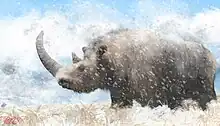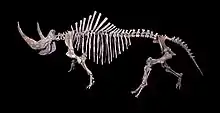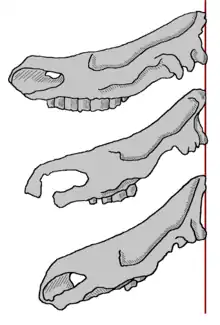Coelodonta
Coelodonta (/koʊiloʊˈdɒntə/, from the Greek κοιλία, koilía and οδούς, odoús, "hollow tooth", in reference to the deep grooves of their molars) is an extinct genus of rhinoceros that lived in Eurasia between 3.7 million years to 14,000 years ago, in the Pliocene and the Pleistocene epochs. It is best known from the type species, the woolly rhinoceros (Coelodonta antiquitatis), which ranged throughout northern Eurasia during the Pleistocene. The earliest known species, Coelodonta thibetana, lived in Tibet during the Pliocene, with the genus spreading to the rest of Eurasia during the Pleistocene.
| Coelodonta Temporal range: Pliocene - Late Pleistocene | |
|---|---|
 | |
| The woolly rhinoceros, Coelodonta antiquitatis. | |
| Scientific classification | |
| Domain: | Eukaryota |
| Kingdom: | Animalia |
| Phylum: | Chordata |
| Class: | Mammalia |
| Order: | Perissodactyla |
| Family: | Rhinocerotidae |
| Tribe: | Dicerorhinini |
| Genus: | †Coelodonta Bronn, 1831 |
| Type species | |
| Coelodonta antiquitatis (Blumenbach, 1799) | |
| Species | |
| |
Species


Species recognised as members of Coelodonta, according to Deng et al. (2011), include:
- Coelodonta thibetana (Deng et al. 2011): The most primitive species of the genus, inhabited the Tibetan Plateau during the Pliocene.[1]
- Coelodonta nihowanensis (Chow, 1978): A primitive species from northern China, it lived in the earliest Pleistocene.[1]
- Coelodonta tologoijensis (Beliajeva, 1966): Appeared in northern China around 2 million years ago, and was present in eastern Eurasia during the Early-Middle Pleistocene.[2]
- Coelodonta antiquitatis (Blumenbach, 1799): The type species of the genus, commonly known as the woolly rhinoceros. It lived in the steppes of northern Eurasia during the Middle and Late Pleistocene, and was the last living representative of the genus.
Phylogeny
DNA evidence suggests that the Sumatran rhinoceros (Dicerorhinus sumatrensis) is the closest living relative of Coelodonta, with Coelodonta also being closely related to the extinct genus Stephanorhinus.[3]
Cladogram of living and subfossil rhinoceros species based on nuclear DNA after Liu et al, 2021:[3]
| |||||||||||||||||||||||||||||||||||||||||||
† denotes extinct taxa
Bayesian morphological phylogeny (Pandolfi, 2023) Note: This excludes living African rhinoceros species.[4]
| |||||||||||||||||||||||||||||||||||||||||||||||||||||||||||||||||||||||||||||||||||||||||||||||||||||||||||||||||||||||||||||||||||||||||||||||||||||||||||||||||||||||||||||||||||||||||||
References
- Deng, T.; Wang, X.; Fortelius, M.; Li, Q.; Wang, Y.; Tseng, Z.J.; Takeuchi, G.T.; Saylor, J.E.; Säilä, L.K.; Xie, G. (2011). "Out of Tibet: Pliocene Woolly Rhino Suggests High-Plateau Origin of Ice Age Megaherbivores". Science. 333 (6047): 1285–1288. Bibcode:2011Sci...333.1285D. doi:10.1126/science.1206594. PMID 21885780. S2CID 8913866.
- Uzunidis, Antigone; Antoine, Pierre-Olivier; Brugal, Jean-Philip (July 2022). "A Middle Pleistocene Coelodonta antiquitatis praecursor (Mammalia, Perissodactyla) from Les Rameaux, SW France, and a revised phylogeny of Coelodonta". Quaternary Science Reviews. 288: 107594. Bibcode:2022QSRv..28807594U. doi:10.1016/j.quascirev.2022.107594.
- Liu, Shanlin; Westbury, Michael V.; Dussex, Nicolas; Mitchell, Kieren J.; Sinding, Mikkel-Holger S.; Heintzman, Peter D.; Duchêne, David A.; Kapp, Joshua D.; von Seth, Johanna; Heiniger, Holly; Sánchez-Barreiro, Fátima (24 August 2021). "Ancient and modern genomes unravel the evolutionary history of the rhinoceros family". Cell. 184 (19): 4874–4885.e16. doi:10.1016/j.cell.2021.07.032. ISSN 0092-8674. PMID 34433011.
- Pandolfi, Luca (2023-01-19). "Reassessing the phylogeny of Quaternary Eurasian Rhinocerotidae". Journal of Quaternary Science: jqs.3496. doi:10.1002/jqs.3496. ISSN 0267-8179.